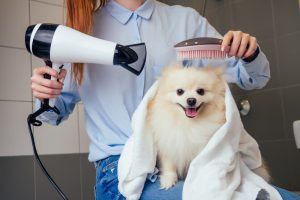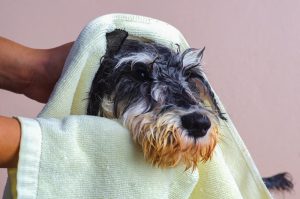Austin Doggie Blow-Drying Specialists
Nobody likes a damp dog. After a bath, we won’t just send your pet home with wet fur or a towel-dry. Your dog will be sent home with dry and fluffy fur courtesy of a nice blow-dry. Blow-drying is a safe way to keep your pet’s fur free of moisture after a bath and gets your dog dry in the shortest time after grooming.
Make sure your dog gets the pampering it deserves in a safe, healthy environment. Call the Austin dog bathing and grooming experts of Walk! ATX at (512) 655-9557 today to make an appointment.
It Is Safe

Blow-drying is safe for your dog when done properly. There are things we do to keep your pet calm and happy during a blow-drying, so it is enjoyable for everyone.
Dogs can be frightened by the loud noise and blast of air at first, so we will take our time to make sure your pet is accustomed to the sound.
Blow-drying is done with a cool high-velocity dryer, similar to the ones used in human hair salons. It isn’t too cold, of course, because we don’t want your pet to get chilled after a bath, but it isn’t hot. Dogs’ skin is very sensitive and burns easily, so the blow dryer should not blast heated air directly onto it. The temperature needs to be as low as that necessary for a toddler’s skin.
High-velocity dryers both blow the water from the dog’s fur and cause quick evaporation, leaving the fur soft and silky. This speed-drying keeps the dog from getting cold and makes the experience easy and stress-free for your dog.
Cage Drying
If your dog is unable to tolerate a handheld blow dryer, we can try a cage dryer. With this method, your dog is placed in a small cage, and a fan, called a force dryer, is placed against a small opening in the cage. It blasts, or forces, warm air into the cage.
The disadvantage of cage drying is that we can’t brush your dog while it dries off, and the dryer is very loud and stressful for the dog. Animals sometimes overheat while in a cage dryer, so they must be checked often. It is most effective for small, nervous dogs who dislike being handled (and for cats, with their sharp little feet).
Brushing and Drying
Dogs are brushed before their bath, to remove excess dirt and hair. This also helps avoid “whip knots,” which are tangles that form in long-haired breeds when they’re being brushed out after a bath. Mats form around dirt and clumps of dead hair embedded in the coat and become worse when they are wet.
To ensure smooth, even drying, the groomer dries one section of fur at a time, drying from the skin out, in the direction of fur growth. For long fur, the groomer will brush the fur out with a slicker brush and follow it with the dryer nozzle, just like your own stylist does in the salon.
This method prevents small moist spots on the skin, which can lead to the growth of ringworm or moist dermatitis. If you have seen your dog biting or licking at a spot on its fur after a bath, it is probably due to a damp patch the dog is trying to dry off.
Your Time to Dry
 If you ever need to dry your dog yourself, whether because you bathed it at home or you’ve been having a fun day in the water, there are a few things to remember.
If you ever need to dry your dog yourself, whether because you bathed it at home or you’ve been having a fun day in the water, there are a few things to remember.
- Air drying. Short-haired breeds can sometimes dry themselves with a vigorous shake and a quick run around the backyard. The drawback, of course, is having a soggy dog in the house on the furniture. Long-haired breeds should not be allowed to air dry, and small and toy breeds can become chilled if left wet for too long.
- Towels. Towel-drying your dog is always a good idea, as long as it’s done correctly. Unlike humans, dog fur is not suited for vigorous rubbing. Since it is finer and has a dense undercoat, rubbing can cause matting and tangles. Instead, press the towel on the dog’s fur to absorb the water. You will probably need many towels for dogs with thick or double-furred coats.
- Quick-dry sprays allegedly help “wick” the moisture away from the dog’s coat and reduce drying time, but professional users have said they see very little difference between using these sprays and not using them. If you swim or play around water with your dog, you may want to try them and see which, if any, of these sprays make a difference to your pet.
- Dry everywhere. Even if you let the air do the work, make sure the dog’s ears, between the legs, and any skin folds are dry. Wrinkly dogs like bulldogs, Shih Tzus, and hounds should be dried carefully after any wetting to avoid skin irritation.
Besides clean fur and healthy skin, dogs enjoy baths and blow-drying because it stimulates the nerves of the skin and increases blood flow. Just as you feel invigorated after a trip to the salon, your dog will feel better after a trip to the groomer.
Letting Professionals Do the Work
We do a careful and thorough job with our bath and blow-dry to make sure your dog’s fur and skin are clean and dry. Dogs should be bathed about once a month to keep their fur free of dead hair and mites. Dogs with heavy fur may not need to be bathed that frequently if they are brushed regularly. Your vet can advise you if your pet needs to see a groomer more often.
After the first visit, your dog will become accustomed to the routine, and we will be better able to give your pet the pampering it deserves. Besides the bath and blow-dry, we can check your dog’s ears, trim toenails, and check the face for any irritation and tear-stains from runny eyes.
At Walk! ATX, we are anxious to meet you and your pet and start both of you on a long and friendly relationship with us. Call us today for an appointment for a good bath and blow-dry. We offer other services as well, including pet sitting, training, walking, and doggie daycare. Call Walk! ATX at (512) 655-9557 for your appointment today.